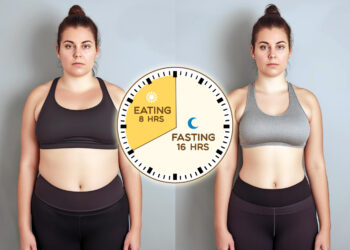Intermittent fasting is all the rage these days, but many people don’t know how it actually works. Some of you may have heard that intermittent fasting (IF) increases fat loss and helps you lose weight faster. But how does IF work? How can intermittent fasting help or hurt your body?
How much weight can you realistically expect to lose if you start an intermittent fasting diet? And does this diet even work when combined with exercise? Let’s find out!
What is Intermittent Fasting?
Intermittent fasting is a type of diet where you limit your food intake to a particular period. One of the most popular IF diets, known as the 16:8 intermittent diet, includes eating in an eight-hour window and fasting for the remaining 16 hours. You can learn about the different types of intermittent fasting here.
Intermittent fasting is not only beneficial for weight loss and fat burning but it can also be good for your overall health and brain function. It has been shown to help with diabetes, epilepsy, Alzheimer’s disease, autism, Parkinson’s disease, and more. One study found that people who practice intermittent fasting lost about six percent body fat after six months, which was 10 times greater than those who dieted without engaging in any form of fasting. The participants in this study were required to go at least 18 hours between eating, meaning they could have breakfast at 8:00 AM one day and then again around the same time the next day. In other words, they would skip lunch and dinner daily. When it comes to fat burning, research shows that fat molecules build up in our cells during fasting. [1]
After 18 hours of fasting, fat cells start breaking down their own fat molecules to be used as a source of energy. Hence the decrease in body fat percentage and appetite suppression from skipping meals.
Level Up Your Fitness: Join our 💪 strong community in Fitness Volt Newsletter. Get daily inspiration, expert-backed workouts, nutrition tips, the latest in strength sports, and the support you need to reach your goals. Subscribe for free!
What Happens to Your Body When you Fast?
The body starts burning fat during intermittent fasting once it enters a state of ketosis. Ketosis is the process that breaks down fat cells to release fatty acids and glycerol for use as energy. It also results in ketones being released into the bloodstream. Ketones are produced when there is a lack of insulin in the body.
So, the whole purpose of intermittent fasting is to reduce your overall calorie consumption and help your body enter the state of ketosis. This happens in three simple phases:
Phase 1 or Fed Stage
In the first few hours of fasting, your body goes through a process called the gastrocolic reflex. This process refers to your body digesting and breaking down food. When you consume a meal, your body releases insulin. Insulin is a hormone released by the pancreas in response to increased blood sugar. It helps transport glucose to muscle and fat cells.
You might experience high glycogen or blood sugar levels if you consume high-carb meals. These excess sugars are stored in the liver and muscles and act as the primary energy source. It also increases other hormones, such as leptin, which suppresses appetite. A fast is reset to a fed state when you eat food during a fast.

Phase 2 or Fasting Stage
Once all the food is digested and processed, your glycogen stores start depleting. When your liver runs out of its glycogen reserves, your body starts to convert fats into ketones. Once you’re in this stage, you’ll burn body fat.
When you fast for 12 to 14 hours and consume a low-carb diet, you might enter a fat-burning phase faster than those who eat a lot of carbohydrates throughout the day. Those who consume a high-carb diet will need to go through the third phase of entering ketosis.
Phase 3 or Extended Fasting Stage
Those who consume a high-carb diet may struggle to enter the state of ketosis that triggers fat burning. If you are one of these people, you’ll need to fast for an extended period.
Fasting for 16 to 20 hours has several benefits like achieving low glucose levels, the onset of ketosis, and an increase in metabolism.
So, when does the body start burning fat? It takes approximately 12 hours for the body to go through each one of these phases. Some people might take longer due to certain variables. However, on average, it’s 12 hours.
Caution For Intermittent Fasting For Prolonged Periods
Prolonged fasting can have negative effects on the body. If you’re going to be fasting for more than three days, you should consult your physician first. Your body needs a certain amount of food and drink each day to function properly and without interruption.
If you don’t fuel your body properly while on a fast, you could experience:
- Headaches
- Fatigue
- Irritability
- Diarrhea
- Dry mouth or throat
- Dizziness, Insomnia, or difficulty sleeping
It also may cause problems with digestion (e.g., nausea or constipation) or anemia. So please don’t fast for longer than three days without consulting your physician.
Level Up Your Fitness: Join our 💪 strong community in Fitness Volt Newsletter. Get daily inspiration, expert-backed workouts, nutrition tips, the latest in strength sports, and the support you need to reach your goals. Subscribe for free!
Common Fasting Mistakes
Intermittent fasting is a great way to lose weight, improve your health, and gain more control over your life. But if you don’t do it correctly, you might end up losing muscle instead of fat.
Here are the four mistakes that can sabotage your intermittent fasting efforts:
- Eating too much leading up to a fast.
- Eliminating fatty foods before or during a fast.
- Overloading sugar and carbs after your fast ends.
- Trying to sustain a long-term fast (more than 2-3 days).
As a general rule, fasts lasting longer than 24 hours should be reserved for experienced folks. When you start out, stick to shorter fasts (1-2 days) until you get more comfortable with the process and how your body responds to it. It will help you avoid a situation where you end up stuffing yourself with carbs and fats to compensate for the strict fasting regimen, undoing all of your progress.
Sample intermittent fasting schedule with examples
Intermittent fasting involves cycling between periods of fasting and non-fasting. There are many different forms of intermittent fasting, but the most popular schedule is 16/8 intermittent fasting, which includes fasting for 16 hours and eating in an eight-hour window.
Studies have found that people who fasted intermittently burned more fat after their meals than those who didn’t fast [2]
Here’s an example schedule for intermittent fasting:
- Monday – Friday: Fast from 7 pm to 11 am
- Saturday & Sunday: Eat normally
Tip: Intermittent Fasting (IF) Calculator helps you cycle between eating and fasting.
Things To Consider Before Starting IF
The first thing to consider before starting IF is the type of fast you will be doing. Some people only eat during a particular window each day, while others fast for two days and then eat for two days. There are many different fasting schedules and it’s important to do your research before deciding which one is best for you.
The second thing to consider is how long your fasts will last. Some intermittent fasting protocols are as short as eight hours, while others extend well beyond 24 hours. It’s important to do some research on the fasting schedule you plan to follow.
For example, if you plan on practicing intermittent fasting on a Monday through Friday basis, ensure you’re eating enough on your
non-fasting days and remember to practice cushioning. Cushioning involves eating more than usual before starting a fast and slightly less in the eating window during a fast.
For example, a 5:2 diet involves eating a regular diet five days a week and restricting your calorie intake to 500-600 per day on the other two days.
Those following the alternate-day method might eat whatever they want one day and then fast for the next day.
Tips To Make Intermittent Fasting Easier
Intermittent fasting can be a great way to boost your metabolic rate and start burning more fat. But, it can be tough to do if you have a busy schedule. Try these five tips for making intermittent fasting easier:
- Eat plenty of healthy fats: Eating healthy fats like avocado, olive oil, or coconut oil will give your body the energy it needs during the fasting window.
- Eat enough protein: Protein helps repair and build muscle tissue and will keep you feeling full for longer.
- Drink lots of water: Staying hydrated is essential because you’re not consuming any calories during intermittent fasting, which means your body might try to hold on to water.
- Create a plan: Intermittent fasting can be hard to stick with when you don’t have a plan. Make sure you know exactly what you’re going to eat in your feeding window
- Find support: It’s a lot easier to do something when you have support. If you can’t find any friends or family members that want to join you in intermittent fasting, try connecting with like-minded people on social media. You’ll find plenty!
Frequently Asked Questions
What is the best intermittent fasting window to lose belly fat?
Many people perform fasting for different reasons. Some perform it for religious reasons, detoxification, while others use it to speed up fat loss. Some methods are more aggressive than others, but they will all help you shed a few pounds. Notably, you cannot choose to burn fat in specific areas. Spot reduction is a myth. Your body will naturally burn fat all over while following a fasting program.
Does fat burn before muscle when fasting?
There are many factors that determine how your body will respond to fasting and the state of ketosis. It is predominantly dependent on your nutrition and lifestyle. However, your body will first burn glycogen stored in muscles and the liver. Then, during the adaptation process, there may be a possibility for your muscles to be affected. However, your body will generally start to burn fat for fuel rather than break down muscles.
How your body burns fat while fasting?
There are many reasons why this dieting strategy is so successful in helping people lose weight and burn fat. Firstly, your overall calorie intake is significantly reduced, which helps you enter a caloric deficit. A caloric deficit refers to consuming fewer calories than your body expends in a day. This triggers a number of biological responses, leading to fat burn. The second reason is that it helps your body enter the state of ketosis.
Learn more about fasting
- Anabolic Fasting: Learn About Building Muscle and Losing Fat Simultaneously
- I’m a Fasting Expert: This is the One Mistake That Destroys Fat Loss During IF
- Inflammation Calculator & Personalized Action Plan
- Dry Fasting Calculator: Estimate Your Weight Loss & Safety Risks
- Intermittent Fasting Weight Loss Calculator: Discover How Much You Can Lose
- Intermittent Fasting vs. Small Meals: Which is Best for Weight Loss?
Summary
The human body usually starts to burn fat after remaining in a fasted state for over 12 hours. This is because the body perceives the lack of food as a sign of starvation and starts to use stored fat as its primary source of energy. On top of that, depending on how long you perform fasting for, your body can also enter the state of ketosis. This means that you’ll also benefit from the production of ketones. However, other factors also come into play. For example, fasting is an incredible strategy to boost your metabolism. Your metabolism has a significant effect on how your body metabolizes food. The faster your metabolism, the more calories you burn at rest. This can also contribute to weight loss.
All these effects of IF make your body much more effective at burning fat. We hope that you’ve enjoyed this article, let us know your thoughts in the comments!
References
- Welton S, Minty R, O’Driscoll T, Willms H, Poirier D, Madden S, Kelly L. Intermittent fasting and weight loss: Systematic review. Can Fam Physician. 2020 Feb;66(2):117-125. PMID: 32060194; PMCID: PMC7021351.
- Mandal, Sumona, Simmons N, Awan S, Chamari K, Ahmed I. Intermittent Fasting: Eating by the Clock for Health and Exercise Performance. PubMed Central (PMC), 2022 Jan. 8 (1). PMID:35070352; PMCID: PMC8744103











